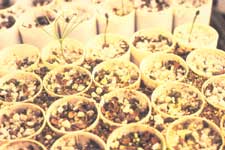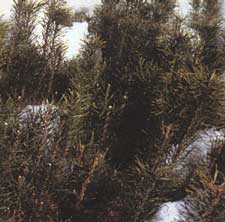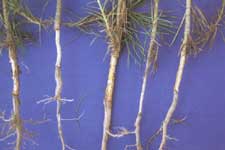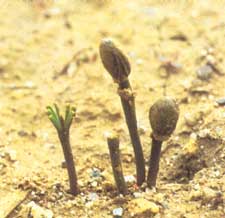Animal DamageTerrell P. Salmon - Wildlife Specialist in Animal Damage, University of California, Cooperative Extension, Davis, CA, and Cordell C.E., Anderson R.L., Hoffard W.H., Landis T.D., Smith R.S. Jr., Toko H.V., 1989. Forest Nursery Pests. USDA Forest Service, Agriculture Handbook No. 680, 184 pp. Hosts Conifers often experience damage caused by animals, with pine species and Douglas-fir the most damaged (via browsing, seed loss, and tree death). But all species appear to be susceptible to seed, stem, or foliage damage. Animals also eat nursery seedling roots, particularly the roots of spruces and pines. Distribution Seed damage due to animals is a significant problem in all areas, particularly in the West. Stem or foliage injury is also widespread. It is a significant problem in more than half the nurseries in the West and in a third of those in the Midwest and East. Some root damage is being reported in all areas of the United States. Rabbits, mice, deer, and, in some cases, birds and ground squirrels are most responsible for stem or foliage damage. The pocket gopher causes a majority of the root damage, but mice, moles, and ground squirrels are responsible in some cases. Damage Seed consumption by animals can significantly lower seedbed density, sometimes to the point that beds must be replanted. Clipping by browsing animals can result in seedling death or malformation. Burrowing animals cause damage by eating parts of or entire root systems, exposing roots to desiccation, and even covering small seedlings by surface mounding caused by burrowing activities. Root damage in general is less common than that to seed and aboveground plant parts. Animals Causing Damage Birds destroy most of the seed, but mice and ground squirrels are troublesome in some nurseries. Deer and squirrels feed on large seeds, such as acorns and nuts. Diagnosis Rodents gnaw seeds open and remove the edible endosperm in one entire piece. On pine seeds, look for teeth marks along the seedcoat margins. On Douglas-fir seeds, rodents gnaw at the micro-pyle end of the seed, producing canoe-shaped hulls. Look for seed hulls and caches of uneaten seeds (fig. 56-1) stored by rodents and birds in sheltered areas. Birds commonly remove the entire seed from the area: the presence of birds is often the only clue that this type of seed loss is occurring. Obviously, seeing the animals themselves or finding their feces or tracks will help you identify the cause of damage to acorns, walnuts, or other large seeds. Clipping injury caused by rabbits, hares, and small rodents can usually be identified by a smooth, oblique cut on the woody stem or on the cotyledons, needles, or leaves. Deer-browsing injury is characterized by a splintered, ragged break on the woody section (fig. 56-2). Meadow voles remove basal bark from young seedlings, giving them a fuzzy, finely gnawed appearance (fig. 56-3). Voles are normally active during the day. Birds feed on seedling tops (fig. 56-4) and can uproot young seedlings. Burrowing animals, such as moles or pocket gophers, can often be detected by the presence of surface mounding or tunnel openings. Look also for animals or the presence of fecal pellets, tracks, or other signs of animal activities. Control When animals cause problems in forest nurseries, several steps should be followed. First, correctly identify the species causing the problem: then, if practical, alter the habitat to make it less desirable to that species. If population reduction is necessary, use an appropriate control method. Finally, establish a monitoring system to detect reinfestations. The following techniques will help minimize damage. Biological - Natural factors, such as food, shelter, and weather, limit populations of all animals. Though rodents, rabbits, and birds are prey for various animals, predators cannot keep their populations low enough to prevent damage in nurseries. Predators are an integral component of the natural ecosystem and, therefore, should be encouraged where their presence does not pose a problem. Cultural - Eliminate any cover of heavy debris, brush, grass, and weeds surrounding the nursery. Eliminating cover by chemical means can sometimes create a barrier to movement of small mammals and facilitates the detection and monitoring of many vertebrate pests. Mechanical - Use screens and nets to protect seeds and seedbeds from birds and other animals. A fairly rigid material with fine mesh will keep birds from becoming entangled. The screen or net must be elevated above the seedbed or seedlings so animals cannot reach them with their beaks or paws. If rodents or rabbits are a problem, the edge of the netting should be buried to prevent their digging beneath it: however, this will not prevent entrance in all cases. Use a 7- to 8-foot woven wire fence or nylon net to exclude deer and other large mammals. Openings in the fence should be no larger than 4 in. Tight attachment to the ground is important because deer frequently try to go beneath fences. Electric fences can also be used. Use a 30- to 36-in high fence of wire mesh to exclude meadow voles and rabbits. Holes should be no larger than 1/4 in for voles and 1 in for rabbits. The bottom 6 in should be turned outward and buried in the ground 6 in. The fence must include tight-fitting gates and sills to keep animals from digging below the bottom rails. Protecting individual trees may be more practical than fencing the entire area. Place cylinders of poultry netting, wire, or plastic mesh around young trees. The cylinders should be braced so the animals cannot press them against the tree or foliage and feed through the mesh. Several commercial tree protectors are available. Trapping is practical for controlling animal pests whose numbers are not too great. Select the trap designed for the animal. It is usually best to bait traps and leave them unset for several days. When the animal is readily taking the bait, set the trap. Trap placement is often extremely important. Areas such as tunnels, burrow openings, or holes in a fence are excellent choices. Often these trap sets do not require baiting. Shooting can be effective for certain animals whose populations are fairly low. Shooting has the additional advantage of producing frightening sounds. Before a shooting program is undertaken, check local laws and regulations. Devices that produce frightening sounds or lights or both, such as firecrackers, propane guns, whistIes, horns, scarecrows, flashing lights, and various other alarm devices can frighten birds and, occasionally, large mammals. But these methods may not suffice to protect seeds and seedlings continuously for extended periods. Their effectiveness may be improved by varying the stimulus and by reinforcing the fright with another approach. Chemical - When using repellents or toxic baits, always follow label instructions. Repellents can be effective against some animals, but no single chemical is a universal repellent. Use repellents on seeds or foliage. Since new growth is not treated and most chemicals wash off, frequent treatments are usually necessary. If the target animal is hungry and little other food is available or if the protected food item is highly palatable, the repellent will probably be less effective. Toxic materials have been developed to control local populations of certain vertebrate pests. Materials such as zinc phosphide can be used to coat or impregnate grains or pellets (baits), making them toxic to the target animal in a single feeding. Poor or inadequate baiting, however, may result in the target animal not receiving a lethal dose. In these cases, the animal may no longer eat that type of bait. For this reason, it is not a good idea to use single-feeding baits more than once per year. Baits coated or impregnated with an anticoagulant require several feedings over a period of 5 or more days to be lethal, and their effectiveness is greatly reduced if 48 hours or more elapse between the feedings. For this reason, an adequate supply of bait must be present at all times. To ensure this, use a bait box or similar structure to store extra bait, protect it from weather, and exclude nontarget animals. Selected References Lawrence, W.H.; Kverno, N.B.; Hartwell, H.D. 1961. Guide to wildlife feeding injuries on conifers in the Pacific Northwest. Portland, OH: Western Forestry and Conservation Association. 44 p. Radwan, M.A. 1970. Destruction of conifer seed and methods of protection. In: Dana. RH., ed. Proceedings, 4th vertebrate pest conference: 1970 March 3-5: Sacramento. CA. Sacramento. CA: [Publisher unknown]: 77-82. Timm. R.M. 1983. Prevention and control of wildlife damage. [Place of publication unknown]: Great Plains Agricultural Council. Nebraska Cooperative Extension Service. [Unnumbered pages.] U.S. Department of Agriculture. Forest Service. 1978. Animal damage control handbook. For. Serv. Handb. 2609.22. Regions 5-6. Washington, DC. 278 p. |
Forest Pests: Insects, Diseases & Other Damage Agents |

|
|





